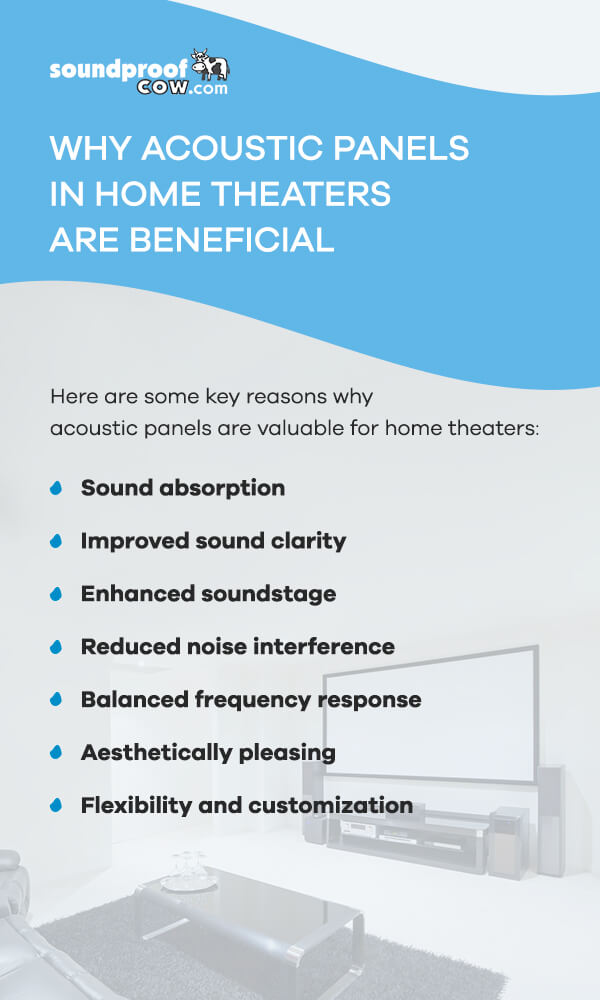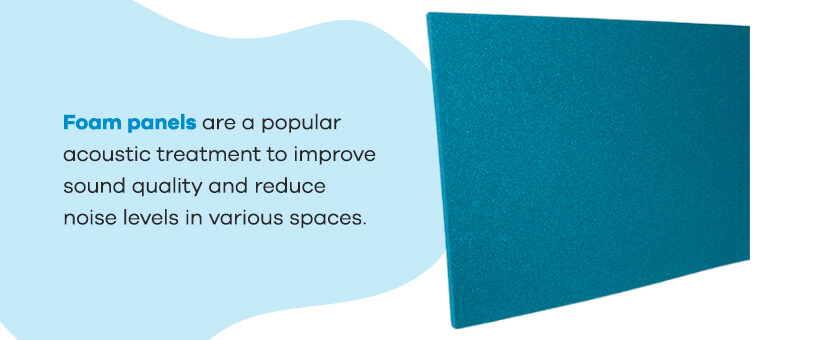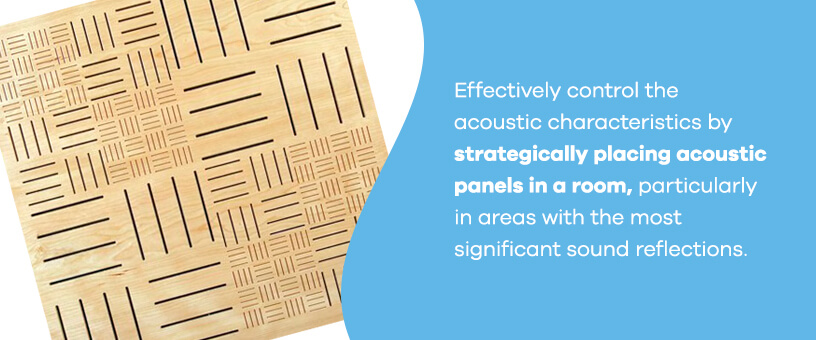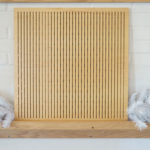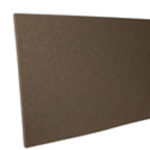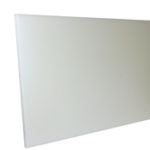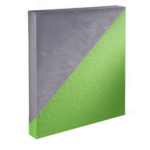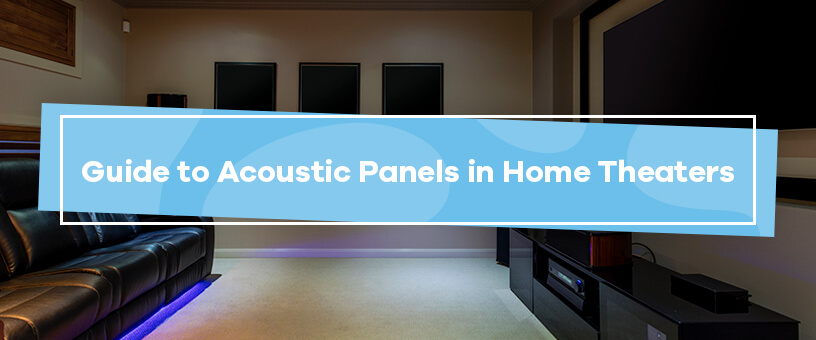
When it comes to creating the ultimate home theater experience, it’s not just about having top-of-the-line audio and visuals. The acoustics of your space play a critical role in delivering immersive sound and ensuring an optimal movie-watching environment. In this comprehensive guide, we delve into the herd of acoustic panels and explore their importance in home theaters. From understanding how they work to choosing the right type, placement and quantity, we can provide you with the knowledge to optimize your home theater’s acoustic performance.
request aN Acoustic Panel quote
What Are Acoustic Panels and How Do They Work?
The fundamental principle behind how acoustic panels work is sound absorption. When sound waves travel through a room, they encounter surfaces such as walls, ceilings and floors. These surfaces can reflect sound waves, causing them to bounce around the room and create echoes or reverberations.
Sound waves penetrate the panel’s porous surface when they reach an acoustic panel. The porous material within the panel is designed to convert sound energy into heat through friction and resistance. As a result, the sound waves lose energy, and their intensity decreases, leading to reduced reflections and a more controlled acoustic environment.
It’s important to note that acoustic panels primarily target the mid and high frequencies responsible for echoes and reflections that can negatively impact sound clarity. Additional measures like bass traps or specialized subwoofers may be necessary to address low-frequency sounds, such as deep bass.
Why Home Theater Acoustic Panels Are Beneficial
Home theaters benefit from acoustic panels because they enhance the audio experience. They improve sound quality and reduce unwanted echoes and reverberations within a room. Here are some key reasons why acoustic panels are valuable for home theaters:
- Sound absorption: Acoustic panels absorb sound waves, preventing them from bouncing around the room and causing audio distortion. They reduce echoes and reverberations by minimizing sound reflections, creating a clearer and more immersive audio experience.
- Improved sound clarity: By minimizing unwanted reflections and echoes, acoustic panels enhance the clarity and definition of sound within the home theater. This allows viewers to perceive dialogue, music and sound effects more accurately, without muddiness or distortion.
- Enhanced soundstage: Acoustic panels help create a more spacious and realistic soundstage within the home theater. They improve sound localization, allowing viewers to perceive the direction and movement of sound more precisely. This creates a more immersive and lifelike audio experience.
- Reduced noise interference: Rooms shared with other living spaces or adjacent to noisy environments often host home theaters. Acoustic panels help to block out external noise sources and prevent sound from escaping the theater, providing a quieter and more focused listening environment.
- Balanced frequency response: Acoustic panels address specific frequencies that may cause problems within a room. They can target and reduce excessive bass and mid-range or high-frequency energy, resulting in a more balanced and accurate frequency response throughout the listening area.
- Aesthetically pleasing: Acoustic panels are available in various sizes, shapes, colors and designs, allowing you to choose options that complement your home theater’s decor. With wall-mounted panels, ceiling clouds or freestanding baffles available, you can choose acoustic panels with functional and aesthetic benefits.
- Flexibility and customization: Acoustic panels can be strategically placed in different room areas to optimize sound performance. Arrange your panels to target specific reflection points or problem areas, providing flexibility in tailoring the acoustic treatment to the room’s unique characteristics.
Overall, acoustic panels play a crucial role in optimizing the acoustic environment of a home theater. By improving sound absorption, reducing echoes and enhancing sound clarity, they significantly enhance the overall audio quality and create a more immersive cinematic experience for viewers.
Best Acoustic Panels for Home Theaters
When selecting acoustic panels for your home theater, it’s essential to consider type and characteristics. The effectiveness of sound panels in your home theater depends on several factors, including the panel’s thickness, density and materials.
Acoustic panels absorb sound energy, preventing it from bouncing off surfaces and reducing the reflections in the room. Manufacturers construct panels using materials with high sound absorption properties, such as foam, fabric or perforated wood.
Thicker panels and denser materials offer better sound absorption across a wider frequency range. Additionally, the panel’s design, such as pyramid-shaped or wedge-shaped patterns, can enhance its absorption capabilities by redirecting sound waves. Here are some popular options:
Foam Panels
Foam panels are a popular acoustic treatment to improve sound quality and reduce noise levels in various spaces. Their design absorbs sound waves and reduces echoes, reverberations and overall noise reflections within a room. Here are some key points about foam panels:
- Acoustic absorption: Foam panels are made from specialized acoustic foam materials with excellent sound-absorbing properties. The foam absorbs sound energy by converting it into heat through internal friction within the foam cells. This absorption helps minimize sound reflections and improve the acoustic quality of a room.
- Types of foam: Foam panels are available in different styles, each with unique characteristics. Common types of foam used for acoustic purposes include open-cell foam and closed-cell foam. Open-cell foam has a porous structure, allowing sound waves to pass through and be absorbed, while closed-cell foam has a denser structure, offering better sound insulation properties.
- Shapes and patterns: Foam panels are available in various shapes and patterns, such as pyramid, wedge or flat designs. These shapes help break up sound waves and prevent them from bouncing back and forth within a room. The specific shape and pattern of the foam panels can impact their effectiveness in diffusing and absorbing sound.
- Thickness and density: Foam panels come in different thicknesses and densities, which affect their absorption capabilities. Thicker foam panels generally provide better low-frequency absorption, while denser panels can absorb a broader range of frequencies. The appropriate thickness and density depend on the specific acoustic requirements of the space.
Combining foam panels with other solutions — such as bass traps, diffusers and soundproofing materials — can provide a comprehensive approach to achieving desired acoustic results.
Fabric-Wrapped Panels
Fabric-wrapped panels are an aesthetically pleasing and versatile option for improving acoustics while adding a touch of style to a room. Here’s some information about fabric-wrapped panels:
- Acoustic performance: Fabric-wrapped panels are designed to enhance sound absorption and reduce sound reflections within a space. Combining the acoustic foam core and the fabric covering helps absorb and diffuse sound waves, improving overall sound quality and clarity.
- Fabric options: Fabric options for wrapped panels allow customers to choose the fabric that best matches their desired aesthetic or blends with the existing decor. The fabric options may include different colors, textures and patterns, enabling customization to suit individual preferences.
- Core material: The core of fabric-wrapped panels typically consists of high-quality acoustic foam. The foam core is responsible for sound absorption and is selected based on the desired acoustic performance. The foam is often wrapped or encased in an acoustically transparent fabric, which allows sound waves to pass through and be absorbed by the foam.
Fabric-wrapped sound panels provide a practical and visually appealing solution for controlling noise and improving sound quality.
Art Acoustic Panels
These panels offer both acoustic treatment and decorative elements to enhance the aesthetics of a space. Here are some key details of Art Acoustic Panels:
- Acoustic performance: Art Acoustic Panels are designed to reduce room echoes, reverberations and overall noise levels. They have an acoustic core that provides sound absorption properties, helping to improve sound quality and clarity within the space.
- Artwork integration: One of the distinguishing features of these panels is the integration of artwork. A selection of artistic designs, patterns, images or custom-printed artwork options allows customers to choose from a range of visually appealing options that align with their preferences and complement the room’s overall design.
- Acoustic performance variants: Art Acoustic Panels come in different thicknesses and densities to offer varying sound absorption and control levels. The specific acoustic performance of the panels can be tailored to meet the requirements of the intended application and room size.
Art Acoustic Panels effectively treat sound-related issues by combining art and acoustic functionality while adding an artistic touch to the space.
Perforated Wood Acoustic Panels
These panels offer a balance between acoustic performance and aesthetic appeal. Here are some key features of Perforated Wood Acoustic Panels:
- Acoustic performance: Perforated Wood Acoustic Panels are engineered to enhance the space’s acoustics by reducing echoes, reverberations and overall noise levels. The perforations in the wood allow sound waves to pass through, where the acoustic core behind the panel absorbs them. This helps to improve sound quality and control within the room.
- Wood finish: These panels feature a wood finish on the visible side, providing a natural and visually pleasing aesthetic. The wood veneer or laminate options allow you to choose from various wood species, colors and finishes to match your desired style and decor.
- Perforation patterns: The panels are perforated with precision-drilled holes in specific patterns. The hole sizes, spacing and patterns can be customized to achieve the desired acoustic performance and visual design. Different perforation patterns affect sound absorption and diffusion, allowing you to tailor the panels to your needs.
Perforated Wood Acoustic Panels offer a combination of effective sound absorption and an elegant wood finish.
Effectively control the acoustic characteristics by strategically placing acoustic panels in a room, particularly in areas with the most significant sound reflections. This helps minimize echoes, reduce reverberations, improve clarity and create a more balanced and pleasing listening experience.
Where to Place Acoustic Panels in a Home Theater
When placing acoustic panels in a home theater, strategic acoustic panel placement is crucial to achieving optimal sound quality and control. Here are some general guidelines for placing acoustic panels in a home theater:
- Reflection points: Identify the primary reflection points in the room. These are the surfaces where sound waves bounce directly off and cause unwanted echoes or colorations. The main reflection points are the side walls, the front wall and the ceiling. Place acoustic panels at these points to absorb and reduce reflections.
- First reflection points: The first reflection points are specific areas where sound directly reflects off the walls and reaches the listener’s ears. To treat these points, mount or place acoustic panels on the side walls at ear level and on the front wall between the speakers and the seating area.
- Rear wall: The rear wall is another critical area to consider. Placing acoustic panels on the rear wall helps reduce reflections and control the reverberation within the room. This can enhance the clarity and intelligibility of the sound.
- Ceiling and floor: Depending on the characteristics of your home theater, adding acoustic panels on the ceiling and the floor may be beneficial. This helps control reflections and reduce standing waves — low-frequency resonances that cause an uneven bass response. Ceiling-mounted panels can also help address sound leakage to adjacent rooms.
- Bass traps: Consider incorporating bass traps besides acoustic panels in the room’s corners. Bass traps are specialized panels that reduce bass buildup and absorb low-frequency sound waves. You can place bass traps in the corners to address standing waves and significantly improve the bass response in the room.
Remember that the quantity and type of acoustic panels for your home theater will depend on the acoustics of your room, the desired sound quality and your personal preferences. You can balance absorption and diffusion throughout the room to achieve a well-balanced and immersive sound experience.
How to Determine How Many Home Theater Panels You Need
Determining the number of acoustic panels you need for your space depends on several factors, including the room size, desired acoustic goals and the type of panels you’re using. Here are some steps to help you determine the number of panels required:
- Assess the room: Evaluate the size, shape and construction materials. Larger rooms require more panels for effective sound control. Pay attention to hard surfaces, such as bare walls, ceilings or floors, as these tend to reflect sound and require more treatment.
- Identify problem areas: Determine the areas in the room that contribute to sound issues, such as excessive echoes, reflections or uneven frequency response. Common problem areas include first reflection points, corners and areas with prominent bass buildup. These areas will typically require more treatment.
- Calculate panel coverage: Calculate the total surface area of the problem areas that need treatment. Measure the height and width of each wall, ceiling and other surfaces requiring panels. Multiply the dimensions to get each surface’s square footage or square meters.
- Placement and distribution: Distribute the panels evenly across the room, targeting your identified problem areas. Place panels strategically at reflection points, corners and other locations based on the specific acoustic issues you want to address. Consider a combination of absorption panels, diffusion panels and bass traps for a balanced treatment approach.
- Professional consultation: Consider consulting with acoustic professionals or working with an acoustics consultant for more precise calculations and personalized recommendations. They can provide detailed analyses and simulations to optimize the placement and quantity of panels based on your specific room and acoustic goals.
Remember that these guidelines are general and may vary depending on the specific characteristics of your space and the desired acoustic outcome. It’s always beneficial to consult with experts or manufacturers who can provide more tailored advice based on your needs.
Request a Quote for Home Theater Acoustic Panels From Soundproof Cow
With the right acoustic panels, you can indulge in your favorite movies, completely immersed in the audio experience. Let the sound transport you to another world as you sit back, relax and enjoy cinema-quality sound from the comfort of your home.
Request a quote from Soundproof Cow for a tailored solution and professional guidance. Improve your movie-watching experience and enjoy the moooving sound of your home theater.



